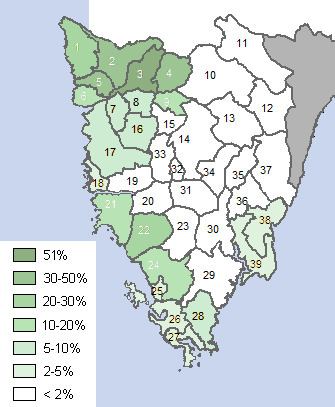 | ||
The Italian language is a minority language in Croatia, spoken by 0.43% of the total Croatian population. It is an officially recognized minority language in Istria County, where it is spoken by 6.83% of the population.
Contents
Italian-speaking population
The 2011 Census in Croatia reported 17,807 ethnic Italians in the country (some 0.42% of the total population). Ethnologue reported 70,000 persons whose first language is Italian or Venetian in 1998 (referring to Eugen Marinov's 1998 data). This population was composed of 30,000 ethnic Italians and 40,000 ethnic Croats and persons declared regionally ("as Istrians"). Native Italian speakers are largely concentrated along the western coast of peninsula Istria. Because of Croatian trade and tourist relations with Italy, many Croats have some knowledge of the language (mostly in the service and tourist industries).
In Istrian contexts the word "Italian" can just as easily refer to autochthonous speakers of the Venetian language, who were present in the region before the inception of the Venetian Republic and of the Istriot language, the oldest spoken language in Istria, dating back to the Romans and now spoken in the south west of Istria in Rovigno, Valle, Dignano, Gallesano, Fasana, Valbandon, Sissano and the surroundings of Pola.
The term may sometimes refer to a descendant of colonized persons during the Benito Mussolini period (during that period immigration in Istria, Zadar/Zara and northern Adriatic islands, given to Italy after World War I, was promoted, 44,000 according to Žerjavić,). It can also refer to Istrian Slavs who adopted Italian culture as they moved from rural to urban areas, or from the farms into the bourgeoisie.
History
In the past the language had a much larger population than it does now: the Italian (Venetian speaking) population constituted (according to the Italian linguist Bartoli) nearly one third of Dalmatians in the second half of the 18th century. According to the Austrian census it had decreased from 22% in 1816 to 12.5% in 1853, down to a mere 2.9% in 1910.
After World War I Italy obtained Zara and some northern Dalmatian islands (Cherso and Lussino). During World War II the Kingdom of Italy annexed most of Dalmatia to the newly created Governatorato di Dalmazia. In 1942 there were 4020 Italians in these newly annexed areas: 2220 in Spalato (Split), 300 in Sebenico (Sibenik), 500 in Cattaro (Kotor) and 1000 in Veglia (Krk).
Furthermore, there were 10,000 Italians in the Governatorato who took Yugoslav citizenship after World War I, in order to remain there and be accepted without problems by the new Yugoslavian regime after the fall of the Austro-Hungarian Empire.
In 1939 Italy conducted a covert census of the non-Italian population (Croats and Slovenes) in Istria, Kvarner, Zadar, Trieste and Gorizia. After the census, Italian authorities publicly stated that the Italian speaking population in those areas had increased. However, data proved that the share of Croatian speakers did not diminish in that period.
For various reasons mainly related to nationalism and armed conflict, the numbers of Italian speakers in Croatia declined during the 20th century, especially after the Second World War in a period known as the Istrian exodus when about 90% Italian-speaking Istrians and Dalmatians left Yugoslav dominated areas in the eastern Adriatic. The 2001 census in Croatia reported 19,636 ethnic Italians in the country.
Italian in use
In Istria County, local government services are provided in Croatian and Italian, including the tri-lingual (Croatian, Italian and English) official government website. There are some Italian-language schools in the region of Istria: primary schools in Buje/Buie, Umag/Umago, Novigrad/Cittanova d'Istria, Poreč/Parenzo, and secondary schools in Pula/Pola and Rovinj/Rovigno.
In the city of Rijeka/Fiume in the Kvarner/Carnaro region, there are Italian kindergartens, elementary schools, and an Italian Secondary School in Rijeka. The daily newspaper La Voce del Popolo, the main newspaper for the Italian Croatians, is published in Rijeka/Fiume.
In various municipalities, census data shows that there are still significant numbers of Italians living in Istria, such as 51% of the population of Grožnjan/Grisignana, 37% at Brtonigla/Verteneglio and nearly 30% in Buje/Buie. In the village there it is an important section of the "Comunità degli Italiani" in Croatia.
